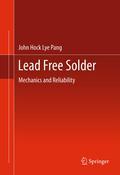
Lead-free solders are used extensively as interconnection materials in electronic assemblies and play a critical role in the global semiconductor packagingand electronics manufacturing industry. Electronic products such as smart phones, notebooks and high performance computers rely on lead-free solder joints to connect IC chip components to printed circuit boards. Lead Free Solder: Mechanics and Reliability provides in-depth design knowledge on lead-free solder elastic-plastic-creep and strain-rate dependent deformation behavior and its application in failure assessment of solder joint reliability. It includes coverage of advanced mechanics of materials theory and experiments, mechanical properties of solder and solder joint specimens, constitutive models for solder deformation behavior; numerical modeling and simulation of solder joint failuresubject to thermal cycling, mechanical bending fatigue, vibration fatigue andboard-level drop impact tests. Discusses lead-free solder materials industry their selection and how theyare currently used industry wide. Focuses on mechanics of materials theory inelastic, plastic, creep, fatigue and fracture assessments. Presents materialstesting and characterization at the macro, micro, and nano scale. Details howto use reliability test and analysis for thermal cycling, cyclic bending and drop impact INDICE: Introduction. Theory on Mechanics of Solder Materials.-Mechanical Properties and Constitutive Models. Fatigue Life Prediction Models. Finite Element Analysis and Design-For-Reliability. Thermo-Mechanical Reliability Test and Analysis. Dynamic Mechanical Reliability Test and Analysis. Thermal CyclingAging Effects on Board-Level Drop Test Result.
- ISBN: 978-1-4614-0462-0
- Editorial: Springer New York
- Encuadernacion: Cartoné
- Páginas: 175
- Fecha Publicación: 28/12/2011
- Nº Volúmenes: 1
- Idioma: Inglés
